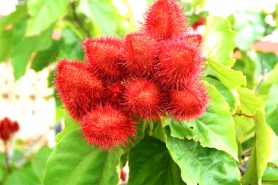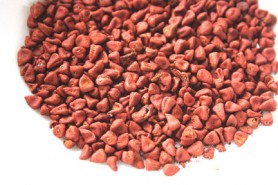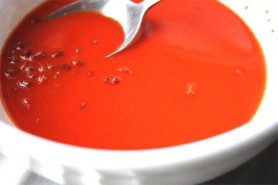Bunches of beautiful ripe, red Annatto can be found on the tree just outside the classroom where I teach. I’ve tried to get my colleagues and students to try using it in their cooking but I’ve had no luck so far. Perhaps I can convince you?

The first time I saw the tree on campus in full bloom I remembered my mom using Annatto when I was a kid. She had gotten it from friends in Trinidad… and was going to use it to colour the stewed chicken she was making.

The stewed chicken had a rich brick-red colour. Say goodbye tomato paste for colouring stewed chicken!
Each year, I pick a few bunches to cook with and to make Achiote oil. The flavours imparted into the oil are subtle; I use it more for the colour rather than the flavour. The oil can be used to cook anything that you want coloured and it makes for a striking presentation when cooked with eggs, used as a salad-oil dressing or just drizzled onto food to make it more appealing.
In certain parts of Southeast Mexico, the Achiote seeds are prepared in two ways for use in cooking. In the Yucatan Peninsula, the seeds are ground together along with other spices and made into a paste called recado rojo. The paste is then rubbed onto to poultry and meat and left to marinate for at least three hours before being cooked. The second preparation is considered to be a purer and a more concentrated form of the achiote. Here, the seeds are boiled in water for several hours until the water has evaporated leaving a concentrated red dye. This concentrated form obviously gives a deeper colour and stronger flavour to the food.

In Trinidad and Tobago, Annatto is often used in the concentrated form. The concentrate is placed in an airtight bottle and refrigerated, ready for use at any time. In some other Caribbean countries, such as Jamaica, achiote has been used as a part of home remedies for heartburn, stomach aches, sunscreen and insect repellent. Today, Annatto is still used as a natural dye for food and cosmetics.
You can find Annatto seeds all year round in supermarkets sold in small packets. If you live in places where there is a Latin American market, then you’ll be able to pick up the ready-made recado rojo and the concentrate. For my part, I usually pick the fresh Annatto and make the concentrate and the oil. I dry whatever else remains for later use.
Once you open the pod, you’ll find clusters of seeds on both parts of the pods – that’s where all the goodness lies. Removing the seeds is easy. If you don’t have the time to boil the seeds to make the concentrate, then you can simply place the seeds in a large bowl, add boiling hot water and let it steep. When it is cool enough for you to handle, then with clean hands, rub the seeds to get off more of the dye.

If you prefer not to make the concentrate or the oil, you can add the seeds directly to the oil just before you add your aromatics and other ingredients. Give it a try; I’m sure you’ll find yourself adding it to many of your dishes for colour. You know how Caribbean people like their foods to have colour.
Achiote Oil
Ingredients
1 cup Canola oil (or your favourite oil)
2 heaped tablespoons Annatto seeds
Method
1. Add the seeds and oil to a pan or skillet and heat over medium heat until you start to hear a sizzle and smell the fragrance of the Annatto. Remove from the heat and set aside until the sizzling subsides. Strain the oil and store in a bottle or air-tight container and use as you would your regular oil.
2. The achiote oil can be rubbed onto to fish or poultry before grilling as well. Gives great colour.
N.B.
Be sure not to overheat the mixture if not the seeds will turn black and the oil will turn green, you don’t want that to happen so don’t walk away from the stove while making the oil.




